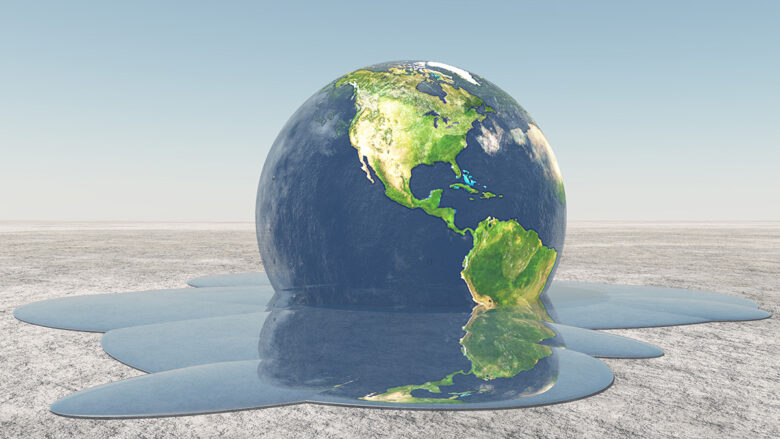The short version
Integrated Assessment Models are stylized neoclassical macroeconomic models that are used to calculate the damage of emitting more carbon into the atmosphere. Doing this allows us to decide on how much we want to invest in transitioning to a green economy, and how fast this ought to be done. The problem? These models are seriously flawed and involve way too much guesswork to be reliable using any sensible definition of that word. Claims that the ‘business as usual’ trajectory would lead to damages of around 2-4% of GDP should not even be taken with a grain of salt. They should be thrown in the bin. Listen to the scientist – half your emissions every decade.
This blog post will use the influential DICE model devised by Nobel laureate William Nordhaus to shed light on some of the problems of using Integrated Assessment Models. The key results are crucially relying on a number of assumptions and calibrations that are poorly, and sometimes not at all, justified. This has led to a plethora of different estimates of the social cost of carbon without there being any clear way of discriminating between them because the results are highly sensitive to untestable assumptions made by the researchers.
In other words, with the “right” parameter calibration and set of assumptions, the researcher will always be able to produce the Social Cost of Carbon estimate that is in line with his prior beliefs. This is the fundamental reason why most Social Cost of Carbon estimates are bullshit. This post specifically talks about DICE, but most of the issues apply to other IAMs.
Context: Bjorn Lomborg and his fellow “Anti-Alarmists”
The recent attention toward sustainability has given rise to a counter-movement of people positing that the risks of climate change are exaggerated. One of the key public figures of this movement is Bjorn Lomborg whose latest book aptly summarises his stance: “False Alarm: How Climate Change Panic Costs Us Trillions, Hurts the Poor, and Fails to Fix the Planet” (a book with repeated misuses of outdated, concocted and misinterpreted numbers [1]).
Now, Lomborg is not a climate denier. He is simply of the belief that there are more important problems that we should focus our resources on and the resources we do dedicate to combating global warming is used inefficiently. These are prima facie reasonable challenges. However, as one of my Berkeley professors put it (paraphrased): ‘he is either very sloppy or dishonest in his writing’. A similar conclusion was drawn by the Danish Committee for Scientific Dishonesty after a year-long assessment of his 2001 book “The Skeptical Environmentalist” [2]. I bring this up not for the sake of undermining his ideas or to say that his hypothesis is clearly incorrect, but rather to highlight how important it is to read how his op-eds and books are received by the scientific community.
To reach the conclusion that we’ve had “[d]ecades of climate-change exaggeration in the West” [3] and in his stride towards “a rational climate policy” [4], Lomborg relies heavily on long-term cost projections of global warming. Citing the IPCC, he writes that global warming, in the unrestrained scenario, will reduce average income by 0.2%-2% by 2070s, juxtaposing this with a “likely” 300%-500% increase in incomes [5]. A small cost in the grand scheme of things, implying that our woes are exaggerated. But exactly where do these numbers come from? And to what extent should we use it as a guide for policy today?
How economists calculate the Social Cost of Carbon (SCC)
William Nordhaus was awarded the Nobel prize in economics, not because his climate model is the most widely accepted, but because he was the first economist to integrate a concern for the climate into the neoclassical Ramsey growth model framework (which is the workhorse macroeconomic model for economic growth using a representative household’s consumption and investment decisions).
Dynamic Integrated Climate-Economy model (DICE) belongs to a larger family of models known as “Integrated Assessment Models” (IAM). These are neoclassical models are used to estimate the social cost of carbon (SCC). To understand SCC, consider the problem of a firm. In an ideal world, the benefits of using fossil fuels should exceed the costs of using them.
The firm receives the benefit of emitting (producing output) and pay the cost of buying the fossil fuel but does not have to consider the costs associated with global warming (a cost that is external to the firm). We can make the firm consider these external costs by setting a tax for each unit emitted. If this tax is set to reflect the social cost of carbon then the firm will be able to weigh the benefits against the costs of emitting carbon appropriately. This is what is meant by ‘optimal’ levels of carbon emissions.
This “optimal” level will imply a certain “optimal temperature” rise. This optimal temperature is based on the idea that there are benefits of using fossil fuel (producing more output and growth in GDP), that must be traded off with the costs.
What are the components of DICE?
DICE estimates the social cost of carbon in three steps: (1) If carbon emissions increase by one unit, how much does the temperature rise? (2) If temperature increase by one unit, how are (a) our ecosystems and (b) humans affected in dollar terms? (3) For a given change in our ecosystems, how are humans affected in dollar terms?
Though this seems relatively straightforward at first sight, neither of the two estimations are easy. The relationship between carbon emissions and temperatures is non-linear, i.e. very complicated. The second and third estimations are all non-trivial as will be elaborated below. If there is something you should remember then it is this: we cannot reliably estimate the social cost of carbon.
Using average global temperature as explanatory variable
As anyone studying economics knows, mathematical convenience is often chosen over realism. This is perfectly illustrated by Nordhaus’ assumptions on the damage function. The damage function refers to the function that translates a given temperature rise to a dollar in lost GDP. The DICE-2016R damage function has two crucial assumptions. First, it uses globally averaged temperature change as a sufficient statistic for damages. Second, it then assumes damages can be “reasonably well approximated by a quadratic function of temperature change”. None of these assumptions are justified.
Think of a situation wherein you are putting your hands over a fire, whilst your feet are in ice water. The average temperature of your body may not rise even though individual parts of your body are suffering tremendously. But as you understand, even though the harm is local at first, the rest of the body will be affected sooner or later – the body cannot rest if one part of it is suffering immensely. The World Bank estimated in 2018 that there will be around 148 million climate refugees by 2050 [17].
The analogy extends even further because global warming is not only geographically asymmetrical in its effects, it is also characterized by “higher highs” and “lower lows” in the sense that the extremes get worse. Using the average temperature completely ignores that it is the variance in temperature that constitutes the biggest damages.
Using a smooth quadratic damange function, igoring tipping points
The justification of using a smooth quadratic damage function used by Nordhaus in his manual for DICE is partially based on his reading of Lenton et al. (2008) – the first attempt to quantify and inter-relate tipping points [10]. They identify 8 climate systems that could be tipped by temperature rise alone within this century, and that the Arctic and Greenland ice are most likely to tip. However, they also note that “at least five other elements could surprise us”. They conclude by strongly rejecting the use of smooth damage functions such as the ones used by Nordhaus: “Society may be lulled into a false sense of security by smooth projections of global change. Our synthesis of present knowledge suggests that a variety of tipping elements could reach their critical point within this century under anthropogenic climate change.”
What is surprising, then is that in the manual for DICE 2013 Nordhaus ignores this completely. He writes that “the current version assumes that damages are a quadratic function […] and does not include sharp thresholds or tipping points, but this is consistent with the survey by Lenton et al. (2008)”. This is simply not a correct reading of the Lenton et al. (2008) paper.
Using cross-sectional data to estimate the damage function
Nordhaus uses a survey of various studies to get the parameter estimates for his damage function. According to Steve Keen, these estimates are based on taking current data on GDP and temperature, doing a regression and saying there’s not much of a relationship between the two [11]. They then say that this (cross-sectional) relationship can be used to predict what will happen with global warming.
This is obviously not true. Temperature is causally affected by three factors: (a) the solar cycle, i.e. the planet’s distance from the sun, (b) solar energy retention by the atmosphere and (c) how far you are from the equator, from oceans and above sea level etc. The cross-sectional approach derives parameters from (c) and applies them to (b).
Confusing ‘Business as usual’ trajectory with global warming reponse
Confounding climate policy with “business as usual”. One of the changes between the 2013 and 2016 versions of DICE was the CO2/GDP trend (decarbonisation rate) numbers used in future projections for the unimpeded climate change scenario. In 2013, the rate of change used was -0.8% per year. However, in light of the annual change of -2.1% between 2000-2015 and recognising that they don’t know to what extent this change reflects policy effects, DICE-2016R puts the decarbonisation rate parameter at -1.5% per year in the 2016 version.
The problem is that between the years 2000 and 2015, we have had 15 climate conferences, the introduction of the European Trading Scheme for emissions rights and a dozen new carbon taxes. All of which directly affect decarbonisation incentives but also indirectly lead to increased decarbonisation by companies efforts because they are strong signals. Companies reduce their CO2 impact in anticipation of more climate policies in the future. DICE assumes -1.5% as the rate of decarbonisation going forward, implying that if we “do nothing” then this is what is likely to happen. It is by no means obvious that this is a correct assumption. Nordhaus does not justify his choice in the paper so I cannot eliminate the possibility that was an entirely arbitrary choice of his. This assumption has huge implications. A ‘business as usual’ rate of decarbonisation of -1.5% implies an aggregate fall of around 36% in 30 years whereas a rate of -1% per year implies an aggregate fall of 18%.
Survey based growth projection
Growth projections are entirely based on survey responses from experts [6]. This should raise more than just one eyebrow. Can these experts forecast 40-80 years into the future with any kind of confidence? Do they have a track record of accurately being able to do so? Expert opinion can be informative in settings familiar to the expert. For example, a veteran driver could plausibly assess the risk of driving on a certain road.
However, in this context, not even the foremost experts on modern growth theory (macroeconomists’ DSGE moels are infamously struggling to match data [8]) or economic history could plausibly claim that the future is a familiar and predictable environment for them. A recent paper by researchers at the Bank of international settlements was entirely dedicated to building a theory that could explain why even professional forecasters have systematically failed to accurately forecast 10-year treasury yields over the past 15 years (fig.2) – “Trend decline in long-term yield largely unforeseen” [21].
One Brookings report evaluating standard neoclassical macroeconomic model forecasting methods put it bluntly: “When evaluating DSGE models […] forecasts inflation and GDP growth very poorly, although statistical and judgmental forecasts do equally poorly.” [9] I find the use of expert surveying highly questionable. Of course, academics would never want to simply stop the forecasting exercise and recognise that they cannot produce a reliable number.
Discounting rate, implicitly based on past and current growth
The majority of the damages we avoid by investing in greener technology today are far away in the future whereas the costs of these investments are incurred today. Economists use consumption as the object which society seeks to maximize over time. To compare future consumption with present consumption, the former is multiplied by a number called the ‘discount rate’. This reflects the idea that an apple in a year is not as valuable as an apple today.
The reason why an apple in a year is not as valuable as one today is that if I have an apple today, then I can sell it and use that money to buy some interest-bearing bonds. In a year, after having received interest on my bond, I will be able to afford (say) 1.1 apples. The discount rate is the number “B” that makes the following equality true (based on the interest rate mentioned before): “apple in a year” * B = “apple today”.
Note here that the interest rate plays a crucial role in determining B. In a flourishing economy with plenty of good investment opportunities, one can expect that the return on investment (interest rate) is quite high. However, if the economy is stagnating and economic growth is on a downward trajectory then interest rates will also be lower. Strictly speaking, one should distinguish between the return on stocks and bonds but for purposes of the present discussion, the above is sufficient.
Nordhaus has an (arguably too low) estimate of how temperature rises will result in reduced consumption in the future. Nordhaus uses a discount rate (or equivalently the real return on investment) of 4.25% over the period until the year 2100. This number is based on the historical rates of return on investment for the US and the rest of the world. The number can also be derived from its theoretical decomposition: (a) pure rate of time preference, (b) per capita growth and (c) intergenerational consumption inequality aversion. All of which are subject to heated discussion within the field or are highly uncertain.
Exclusions of economic sectors
In calculating step 2b) – how a given rise in temperature affects humans in dollar terms – according to Keen [11] economists still use the enumeration method first employed by Nordhaus (1991) [12]. The key assumption was that anything done indoors is immune to climate change: “Our estimate is that approximately 3.0% of United States national output is produced in highly sensitive sectors […], and about 87 % in sectors that are negligibly affected by climate change” (p.930).
This is even made explicit later: “…for the bulk of the economy – manufacturing, mining, utilities, finance, trade, and most service industries – it is difficult to find major direct impacts of the projected climate changes over the next 50 to 75 years.” (p.932). We find the same assumption in chapter 10 (Key Economic Sectors and Services) of the IPCC 2014 report, page 688 [13].
Naturally, this narrow conceptualisation of how temperatures translate into dollar damages will result in much lower estimates of the social cost of carbon compared to more holistic approaches.
The gap between economists’ and scientists’ SCC estimates…
A meta-analysis of 58 studies of the social cost of carbon (SCC) from 2019 gathered 578 estimates of SCC These ranging from −13.36$/tCO2 to 2386.91$/tCO2 [15]. What is even more worrying than the wide span of estimates is that they often result in “optimal” temperature rises that far exceed those given by scientists. Stern and Stiglitz (2021) comment this eloquently [16]
The fact that the overwhelming consensus in the … scientific community, differs so markedly from the rsults of the IAMs raises a key question: is it sloppy thinking … that has led the international community to irrationally embrace a goal involving excessive costs from the perspective of a hard-headed analysis of society welfare maximization; or is it that the IAMs have left something – or many thigns – out of their analysis?
Nicholas Stern and Joseph Stiglitz
Conclusion
In summary, the estimation of SCC is fraught with uncertainties in estimating (a) the emissions paths that are likely in the future as that depends on future policy and technology, (b) the parameters that map emissions to climate change, (c) the translation of climate change into physical and economic damage (i.e. the functional form, considering tipping points), (d) the choice of the appropriate discount rate. Changing some of these assumptions or introducing something like ecosystem services that are not substitutable with man-made capital changes the policy recommendations radically [20].
For a more extensive and eloquent critique of these IAMs I defer you to read Pindyck (2013) who describes these modelling exercises as “pure guesswork” [18]. You may also want to consult the work of Keen (2021) with the provocative title: “The appallingly bad neoclassical economics of climate change” [19].
At the end of the day, I think we should listen to the scientists. They have studied the earth’s ecosystem over thousands of years and concluded that we should really try to stay below 2 degrees. Doing so implies a certain more or less well-defined fossil fuel budget. Apart from the standard carbon taxes, increasing investment in green technology and cap and trade, there is one new idea that I find interesting.
Steve Keen propose an individual carbon credit system that would be set up using central bank digital currencies. This system would mean that all citizens get a certain amount of carbon credits that are used up as they consume goods. This will be politically more palatable since lower-income individuals will likely be able to sell some of their carbon credits to high-income individuals who would have to purchase carbon credits from them in order to maintain their high-carbon lifestyle.
Sources
[1] Ward, Bob. “A closer examination of the fantastical numbers in Bjorn Lomborg’s new book”. Grantham Research Institute on Climate Change and the Environment at LSE. 2020. https://www.lse.ac.uk/granthaminstitute/news/a-closer-examination-of-the-fantastical-numbers-in-bjorn-lomborgs-new-book/
[2] Brown, Paul. “Debunker of global warming found guilty of scientific dishonesty”. The Guardian. 2003. https://www.theguardian.com/uk/2003/jan/09/highereducation.science
[3] Lomborg, Bjorn. “Overheating About Global Warming”. Project Syndicate. https://www.project-syndicate.org/commentary/climate-change-alarmism-scaring-children-by-bjorn-lomborg-2019-03?
[4] Lomborg, Bjorn. “Welfare in the 21st century: Increasing development, reducing inequality, the impact of climate change, and the cost of climate policies”. Technological Forecasting and Social Change. Vol 156. 2020. https://www.sciencedirect.com/science/article/pii/S0040162520304157
[5] Lomborg, Bjorn. “How Climate Policies Hurt the Poor”. Project Syndicate. 2019. https://www.project-syndicate.org/commentary/governments-must-reduce-poverty-not-emissions-by-bjorn-lomborg-2019-09
[6] Nordhaus, William D. “Social cost of carbon in DICE model”. Proceedings of the National Academy of Sciences Feb 2017, 114 (7) 1518-1523. https://www.pnas.org/content/114/7/1518
[8] Wickens, Mike. “Checking if the straitjacket fits: Theory versus statistical fit in macroeconomic modelling”. CEPR Frontiers of economic research Macroeconomic policy. https://voxeu.org/article/theory-versus-statistical-fit-macroeconomic-modelling
[9] Rochelle M. Edge & Refet S. Gurkaynak, 2010. “How Useful Are Estimated DSGE Model Forecasts for Central Bankers?,” Brookings Papers on Economic Activity, Economic Studies Program, The Brookings Institution, vol. 41(2 (Fall)), pages 209-259.
[10] Lenton, Timothy M.; Hermann Held; Elmar Kriegler; Jim W. Hall; Wolfgang Lucht; Stefan Rahmstorf and Hans Joachim Schellnhuber. “Tipping elements in the Earth’s climate system”. Proceedings of the National Academy of Sciences Feb 2017, 114 (7) 1518-1523. https://www.pnas.org/content/114/7/1518
[11] Keen, Steven. “NAEC seminar : Are the estimates of economic damages from climate change erroneous?”. OECD seminar. September 29, 2021. https://oecdtv.webtv-solution.com/d752db229df65e85c0e10cfef44de4cf/or/naec_seminar_are_the_estimates_of_economic_damages_from_climate_change_erroneous.html
[12] Nordhaus, William, (1991), To Slow or Not to Slow: The Economics of the Greenhouse Effect, Economic Journal, 101, issue 407, p. 920-37, https://www.jstor.org/stable/2233864
[13] Arent, D.J., R.S.J. Tol, E. Faust, J.P. Hella, S. Kumar, K.M. Strzepek, F.L. Tóth, and D. Yan, 2014: Key economic sectors and services. In: Climate Change 2014: Impacts, Adaptation, and Vulnerability. Part A: Global and Sectoral Aspects. Contribution of Working Group II to the Fifth Assessment Report of the Intergovernmental Panel on Climate Change [Field, C.B., V.R. Barros, D.J. Dokken, K.J. Mach, M.D. Mastrandrea, T.E. Bilir, M. Chatterjee, K.L. Ebi, Y.O. Estrada, R.C. Genova, B. Girma, E.S. Kissel, A.N. Levy, S. MacCracken, P.R. Mastrandrea, and L.L. White (eds.)]. Cambridge University Press, Cambridge, United Kingdom and New York, NY, USA, pp. 659-708. https://www.ipcc.ch/site/assets/uploads/2018/02/WGIIAR5-Chap10_FINAL.pdf
[15] Wang, Pei; Xiangzheng Deng; Huimin Zhou; Shangkun Yue. “Estimates of the social cost of carbon: A review based on meta-analysis”. Journal of Cleaner Production. Volume 209. 2019. Pages 1494-1507. https://doi.org/10.1016/j.jclepro.2018.11.058
[16] Stern, Nicholas and Jospeh Stiglitz. “The Social Cost of Carbon, Risk, Distribution, Market Failures: An Alternative Approach”. NBER working paper 28472. https://www.nber.org/papers/w28472
[17] Kumari Rigaud, Kanta, Alex de Sherbinin, Bryan Jones, Jonas Bergmann, Viviane Clement, Kayly Ober, Jacob Schewe, Susana Adamo, Brent McCusker, Silke Heuser, and Amelia Midgley. 2018. Groundswell: Preparing for Internal Climate Migration. The World Bank. Pg 2. https://openknowledge.worldbank.org/handle/10986/29461
[18] Pindyck, Robert S.. “Climate Change Policy: What Do the Models Tell Us?”. Journal of Economics Literature. Vol 51(3). 2013. https://www.aeaweb.org/articles?id=10.1257/jel.51.3.860
[19] Keen, Steve. “The appallingly bad neoclassical economics of climate change”, Globalizations, 18:7, 1149-1177, DOI: 10.1080/14747731.2020.1807856
[20] Sterner, Thomas and Martin Persson. “An Even Sterner Review: Introducing Relative Prices into the Discounting Debate”. 2008. Review of Environmental Economics and Policy 2(1):61-76 DOI:10.1093/reep/rem024
[21] Rungcharoenkitkul, Phurichai and Fabian Winkler. “The natural rate of interest through a hall of mirrors”. BIS Working Papers No 974. 2021. https://www.bis.org/publ/work974.htm




Comments
Simply wish to say your article is as surprising. The clarity in your post is just cool and i could assume you are an expert on this subject. Fine with your permission allow me to grab your RSS feed to keep updated with forthcoming post. Thanks a million and please continue the enjoyable work.